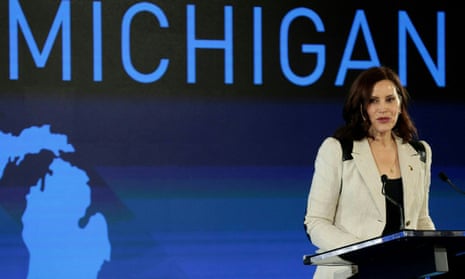Governor Gretchen Whitmer of Michigan announced proudly in August that 100,000 people had applied for her state’s free college program, Michigan Reconnect.
The program, which covers community college tuition for Michigan residents aged 25 or older to get them to go back to school, was “a gamechanger”, Whitmer said, “not only for the people enrolled in the program, but also for their families, small businesses and the state”.
More than 24,000 of those applicants have enrolled in the program, and 2,000 have completed a degree or a certificate, the state’s department of labor and economic opportunity says. It’s part of a wave of 32 such “free college” programs nationwide, according to the Campaign for Free College Tuition – a third of them added in the last five years.
But there’s a hitch. Most statewide programs, including Michigan’s, don’t necessarily help the lowest-income students finish or pay for college.
Many cover only the tuition that is still outstanding after federal aid is used up. These are called “last-dollar” free college programs. Since federal aid to the lowest-income students – usually in the form of Pell grants – almost always covers the full cost of community college tuition, low-income students don’t benefit, while higher-income students do.
Despite a perception that free college programs are meant for lower-income students, “the only students who would qualify are students who aren’t eligible for Pell – wealthier students”, said Wil Del Pilar, vice-president of higher education policy at the Education Trust. “These become messaging bills a lot of the time,” he said of the preponderance of free college legislation.
What low-income students really need is help with other expenses, such as housing, books and transportation – things free college programs don’t often cover. Those essentials account for about 80% of the cost of attending community college, according to researchers at the University of Wisconsin-Madison.
Free college often is “a false promise”, Del Pilar said. “I don’t think equity is at the heart of these programs, because if it was, they would be designed a bit differently than what we see.”
Now a handful of states are trying something different. They’re launching “first-dollar” programs, in which money from the state can be applied first to tuition. That means low-income students can use their Pell grants and other federal aid for all those other costs of college.
This can be a hard sell to legislators, since not all politicians think taxpayers should be on the hook for students’ room and board. Some researchers, including those at the WE Upjohn Institute for Employment Research, estimate that these first-dollar programs can be at least twice as expensive to implement as last-dollar ones.
“All things being equal we prefer first-dollar programs,” said Ryan Morgan, chief executive of the Campaign for Free College Tuition. But it can be tough to win bipartisan support. “There are political realities to paying for students’ meals and housing.”
Some states are trying to do it anyway. New Mexico in the fall launched its Opportunity Scholarship, one of the most generous such programs in the country. It covers full tuition at two- and four-year public colleges and universities, before – instead of after – federal aid kicks in. (The state uses the term “middle-dollar” to describe its scholarship because other state money is applied first.)
The Opportunity Scholarship will cost more than $100m to operate this year, said Stephanie Rodriguez, secretary of the New Mexico department of higher education, and the governor’s office asked for more than $157m to cover it next year. Part of that increase is because it’s been so popular, helping boost enrollment at New Mexico public universities and colleges by 4% in the last year. Some 34,000 students received the scholarship this fall.
But Rodriguez said the investment was worth it.
“What the benefit will be over time is a high return on investment with individuals staying in New Mexico, working in our workforce and having those family-sustaining wages that will keep New Mexico running over time,” Rodriguez said.
The design of the program means that students can stack federal financial aid on top of Opportunity scholarships to cover basic needs beyond tuition. Rodriguez said there was evidence that students are indeed using the scholarships in that way. First-year students including those who get the scholarship also received Pell grants and other federal aid, she said her department found.
At Eastern New Mexico University, about 30% of students at the main campus receive Opportunity scholarships, and others receive separate state aid to help them cover their tuition, said its president, James Johnston. Enrollment grew nearly 7% this fall from the last academic year, Johnston said.
Some states with the more common and less generous last-dollar programs are experimenting with giving students who already used their Pell grants to cover tuition an additional award to help them pay for books and other necessities. Oregon, for example, provides a minimum award of $2,000 to eligible students.

Some experts say that even when free college programs bring no real financial benefit to the lowest-income students, they can still have a positive impact. They can motivate students to look into and eventually pursue a higher education, whether or not they actually end up making any difference in the price. The word “free” is a powerful motivator, advocates say.
“There’s a lot of confusion and uncertainty and lack of transparency around college prices,” said Michelle Miller-Adams, a senior researcher for the Upjohn Institute who studies free college programs. “The benefit of these last-dollar community college programs has more to do with the messaging and the signaling that higher ed is affordable than it does with actually new financial resources.”
The less expensive last-dollar programs also can be more politically viable and likely to win bipartisan support. And they help many middle-income students who find paying for college difficult and might not qualify for other kinds of help.
“There are people right above the Pell cutoff who don’t have access to federal financial aid, but also don’t have a lot of money,” Miller-Adams said. “Making college tuition-free for them is a big deal and great.”
How well a program works and how equitable it is also depends on whether it’s easy to understand. Some have potentially burdensome eligibility requirements, such as cutoffs based on grade-point averages or a requirement that recipients stay in the state for a certain period of time after graduating.
In many state legislatures, the rhetoric around free college has been more about producing workers with the skills employers need than helping the most marginalized students.
That’s the case in Michigan, where Whitmer is now hoping to expand her signature Michigan Reconnect program.
Ryan Fewins-Bliss, executive director of the Michigan College Access Network, said that while first-dollar programs are generally better for students, the last-dollar approach allows Michigan to spread money to more people.
Just a few years ago, the state was near the bottom of the list in terms of money spent on financial aid, Fewins-Bliss said. Now it’s spending millions. With that increase, it’s hard to complain about the details.
“People have lost faith in their government and institutions. We need to renew that by investing in people,” he said. “And there’s no better way to change someone’s life than getting them more education.”
This story about free college programs was produced by The Hechinger Report, a nonprofit, independent news organization focused on inequality and innovation in education. Sign up for our higher education newsletter.
